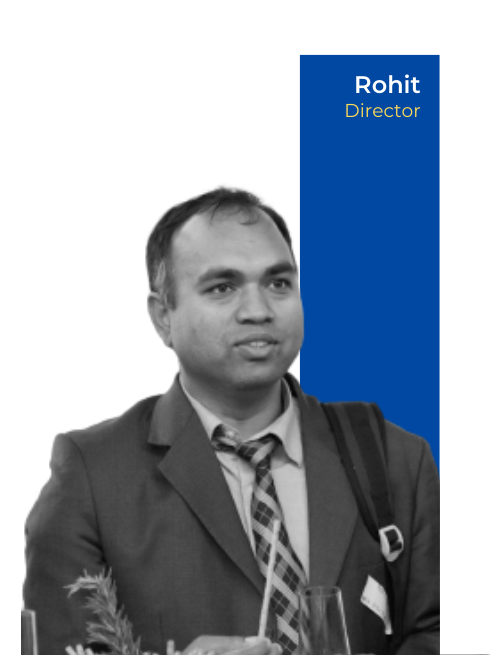As a Founder and Managing Director, Bikram plays a key role in the day to day operations and formulating strategies for smooth execution of research assignments. Bikram is also responsible for client acquisition and client engagements in Asia pacific region. Bikram helps global technology companies monetize their IP assets through automated tools and helps them generate more value out of their IP. He has the expertise of assisting clients on a wide range of technologies such as Semiconductors (circuits and processes), Wireless Technologies, Memory Devices, Cloud Computing, and Consumer Electronics.
Bikram has been advising several Global 500 clients in effective patent portfolio optimization and competitive benchmarking analysis to help them understand their position in the industry. Bikram has extensive experience in assisting clients on high stake US, Japanese and Chinese patent litigation cases. Recently, Bikram has been actively involved in advising clients on new product development strategies and technology Landscape studies.
From facilitating the remote diagnosis of the Covid virus to autonomous driving robots inside the operating room, the advent of 5G networks in healthcare will be one of the best things to happen for the healthcare industry. With its massive connection power and high speed, it has a lot to offer and revolutionize healthcare.
Investments in healthcare technology have increased because of Covid-19. There was a 19% increase in healthcare investments in 2020 when compared with 2019, to the tune of $9.1 billion. According to Gartner, the 5G network infrastructure has risen worldwide by 39% in 2021.
What is 5G?
It is the fifth generation of wireless network technology and is an advanced version of the 4th generation. 1G focused on improving voice quality, 2G did the same, but it also offered consumers the ability to send and receive text messages. 3G was released during the time internet was brought to our phones, 4G was all about data sharing and faster wireless internet connectivity. With 5G networks, we are promised incredibly fast connectivity, extremely low latency, and widespread coverage.
What is the relevance of 5G in healthcare?
The cost of healthcare is seeing a steep increase, and the Covid-19 pandemic has only added to its woes. Inefficient processes, government policies, aging population, disease incidence, and medical service utilization contribute to the increase in healthcare costs.
Some of the biggest technologies in the world such as artificial intelligence (AI), machine learning (ML), IoT, big data, etc, contribute to the development of the healthcare experience for patients. They also help reduce costs for the hospitals.
For example, AI/ML helps in the diagnosis of certain diseases based on the symptoms. Faster communication and a seamless network make telemedicine a reality. But there are problems such as slow network speeds and low latency that don’t help the cause at times. This is where 5G networks can completely change the game for healthcare providers.
While many use cases were explored in healthcare, some of them didn’t meet expectations because of the limitations in the incumbent communication networks. Thanks to features such as low latency, high speed, and fast data transfer rate, 5G will be able to resolve some of the biggest challenges.
What is the need for 5G in healthcare?
- Better security and reliability:
5G gives secure and more reliable service due to better use of bandwidth and more connection points. Because of this, 5G is able to provide ubiquitous coverage too. For healthcare applications, reliable and timely data transmission is pivotal, especially in areas such as augmented-reality powered robotic surgeries, connected ambulances, remote patient monitoring, and so on. Thanks to 5G’s better privacy protection, advanced encryption protocols, software-defined setup, and authentication framework, the networks are more secure.
- Helps expand telemedicine:
Market Research Future says that the telemedicine market is expected to grow at a CAGR of 16.5% from 2017 to 2023. The study says that the increased demand is because of government initiatives. For telemedicine to work successfully, it requires a network that offers high-quality video in real-time. Telemedicine is bolstered by the fact that it can enable mobile networks to work seamlessly. Patients who do not often get access to specialists will be able to get proper healthcare because of 5G networks.
- Connected ambulances:
Connected ambulances help emergency services collect important and real-time information about the patient through sensors, wearables, and streaming HD cameras, while the patient is being taken to a healthcare center. Thanks to this, the healthcare staff have a much better understanding of what the patient requires even before they arrive at the hospital. In serious situations, specialist doctors can even guide the paramedics through certain procedures without having to travel to hospitals.
Connected ambulances cannot be implemented without 5G’s capabilities. Real-time data transfer is pivotal in emergency situations as even minor decisions can have a lot of bearing on patient outcomes. The high bandwidth that 5G offers enables the video to be live-streamed without seeing a dip in quality. Apart from these two, the 5G network’s increased reliability and security make it a must-have for the healthcare industry.
- Video-enabled medication adherence:
Making sure that patients take their prescriptions is a big challenge in the healthcare industry. Patients with chronic diseases will not be able to function properly if they do not take their medicines on time. 5G tackles this problem by connecting pharmacists and care providers directly to the patient to ensure that the medicines are taken on time.
- Clinical collaboration:
Lengthy wait times to get the correct diagnosis can result in a poor experience for the patient, it can even end up harming them adversely. Most of the time, the doctors will be waiting for the results of tests that are being diagnosed in the same healthcare center. Collaboration and communication become a problem and it slows down the progress of the treatment.
A healthcare center that has a 5G platform can easily solve this problem as lab technicians will be able to transfer large files without compromising the quality. The 5G platform connects all the devices within the hospital, starting from medical equipment to devices handled by the caregivers, solving the problem of data accessibility.
- Medical Sensors:
Wearable devices have seen huge strides in adoption as well as an increase in their use cases. A wearable fitness device can monitor your heart rate, skin temperature, ECG, SpO2, sleep cycle, and even your stress levels. With more such technologies facilitating remote patient care and monitoring, the treatment and experience of the patient improve by a huge margin.
Hospitals can even use smartphone cameras to detect melanoma, monitor skin infections, analyze patient injuries, eye problems, etc. The wireless medical sensors can even be used in administering and monitoring medication.
- Real-time remote monitoring:
With the help of IoT devices, healthcare providers can monitor the data of patients to provide timely and personalized care. It also increases patients’ engagement with their own health. One of the biggest obstacles to the success of remote monitoring is the capacity of networks to handle the data. When the connection is unreliable, the healthcare service providers will not be able to make quick decisions.
5G enables real-time remote monitoring because of the following reasons:
- Increased capacity to handle a number of connected devices per square kilometer
- Provides greater reliability and security for the connected devices
- Offers greater mobility
- AR/VR for the blind:
Those who have poor or zero vision will find it difficult to do day-to-day tasks that are easy for others. With the help of augmented reality (AR) and virtual reality (VR).
headset, or a pair of video streaming glasses, visually challenged people can be connected to a real-time person who will guide them in doing their daily activities.
5G helps AR/VR systems to help the visually challenged at scale because:
- 5G’s low latency allows the video to be streamlined in real-time, and it is crucial as a light delay might result in mishaps
- The higher bandwidth that 5G offers allows for higher video quality
- Many of the AR/VR activities will happen seamlessly because of the mobility that 5G offers
- Distraction and Rehabilitative Therapy:
AR and VR can also be used extensively in hospitals to offer a better experience for the patients, especially in distraction and rehabilitative therapy. To give an example of how AR/VR can be used in distraction therapy, we can take the example of a patient who has a phobia of needles. The patient can wear the AR/VR headset, they can choose cloud-streamed videos, and they will be transported to a completely different environment.
- Better patient-doctor relationship:
To give and receive proper care, the relationship between patients and doctors should be great. Thanks to 5G, the communication between both parties happens seamlessly. Artificial intelligence and interconnected sensors can analyze the interactions between patients and the staff. With 5G, there will be better outcomes and much more personalized care. Integration of 5G can also increase the access of doctors. With the help of fast data speeds, patients can interact with doctors from afar. Patients wouldn’t have to walk into a hospital for every minor ailment. By using video chats, they can assess which ones require in-hospital visits.
- Healthcare automation:
Hospitals can leverage the applications, data, and infrastructure that 5G networks will open up to stay a step ahead of their competitors. They can greatly increase their speed, ability to handle complexity, and scale of business operations. Automation plays a huge role in maximizing healthcare value. With the help of 5G, hospitals can automate pivotal business processes and workflows. Potential delays or failures can be detected with the help of predictive analysis before they happen, thereby making them ready for immediate remediation.
- Telesurgery:
Telesurgery requires medical information like audio, videos, and images, to be digitized and transmitted wirelessly via telecommunication networks. Telesurgeries are rare because of concerns over internet reliability and infrastructure. The data connection has to be fast if surgeries have to be remotely monitored. There’s good reason to believe that 5G will make telesurgery a possibility.
Conclusion:
The potential of 5G in healthcare is immense, there are many more applications of this technology. It can improve the quality of the care, reduce the care cost, offer a better patient experience, and more. As the use of 5G in healthcare increases, we will see a connected healthcare ecosystem taking shape that will change the way we receive care. Ultimately, this paves way for better healthcare for everyone.



